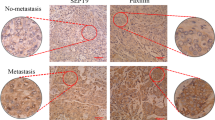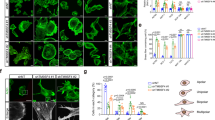Abstract
Sprouty and the Sprouty-related protein, Spred (Sprouty-related Ena/vasodilator-stimulated phosphoprotein homology-1 (EVH1) domain-containing protein), inhibit Ras-dependent extracellular signal-regulated kinase (ERK) signaling induced by a variety of growth factors. Since Sprouty proteins have been shown to inhibit not only ERK activation but also cell migration, we postulated that Spreds also inhibit cellular migration. Using stably highly metastatic LM8 cells infected with the Spred1-Sendai virus vector, we demonstrated that Spred1 inhibits the metastasis of LM8 cells in nude mice. Spred1 overexpression also inhibited migration of cells in vitro in response to chemokines, CCL19 and CCL21. We also found that Spred1 overexpression dissolved actin-stress fibers. Both EVH1 domain and C-terminal Sprouty-related domain were required for actin reassembly. Spred1 and Spred2 suppressed constitutively activated RhoA (V14RhoA)-induced stress fiber formation and serum response factor activation. Spred1 bound to activated RhoA, but not cdc42 and Rac. Spred1 also inhibited chemokine-induced RhoA activation and active RhoA-induced Rho-kinase activation. These data suggest that Spreds are key regulators of RhoA-mediated cell motility and signal transduction. Furthermore, our study suggests that the induction of Spreds could be a novel strategy for preventing cancer cell metastasis.
This is a preview of subscription content, access via your institution
Access options
Subscribe to this journal
Receive 50 print issues and online access
$259.00 per year
only $5.18 per issue
Buy this article
- Purchase on Springer Link
- Instant access to full article PDF
Prices may be subject to local taxes which are calculated during checkout








Similar content being viewed by others
References
Amano M, Chihara K, Kimura K, Fukata Y, Nakamura N, Matsuura Y and Kaibuchi K . (1997). Science, 275, 1308–1311.
Amano M, Fukata Y and Kaibuchi K . (2000). Exp. Cell. Res., 261, 44–51.
Arsenian S, Weinhold B, Oelgeschlager M, Ruther U and Nordheim A . (1998). EMBO J., 17, 6289–6299.
Bonacchi A, Romagnani P, Romanelli RG, Efsen E, Annunziato F, Lasagni L, Francalanci M, Serio M, Laffi G, Pinzani M, Gentilini P and Marra F . (2001). J. Biol. Chem., 276, 9945–9954.
Cabrita MA and Christofori G . (2003). Thromb. Haemost., 90, 586–590.
Callebaut I, Cossart P and Dehoux P . (1998). FEBS Lett., 441, 181–185.
Carnac G, Primig M, Kitzmann M, Chafey P, Tuil D, Lamb N and Fernandez A . (1998). Mol. Cell. Biol., 9, 1891–1902.
Casci T, Vinos J and Freeman M . (1999). Cell, 96, 655–665.
De Maximy AA, Nakatake Y, Moncada S, Itoh N, Theiry JP and Bellusci S . (1999). Mech. Dev., 81, 213–216.
Fuerst TR, Niles EG, Studier FW and Moss B . (1986). Proc. Natl. Acad. Sci. USA, 83, 8122–8126.
Hacohen N, Kramer S, Sutherland D, Hiromi Y and Krasnow MA . (1998). Cell, 92, 253–263.
Hashimoto S, Nakano H, Singh G and Katyal S . (2002). Mech. Dev., 119 (Suppl 1), S303–S309.
Hill CS, Wynne J and Treisman R . (1995). Cell, 81, 1159–1170.
Impagnatiello MA, Weitzer S, Gannon G, Compagni A, Cotten M and Christofori G . (2001). J. Cell Biol., 152, 1087–1098.
Ishizaki T, Maekawa M, Fujisawa K, Okawa K, Iwamatsu A, Fujita A, Watanabe N, Saito Y, Kakizuka A, Morii N and Narumiya S . (1996). EMBO J., 15, 1885–1893.
Izawa I, Amano M, Chihara K, Yamamoto T and Kaibuchi K . (1998). Oncogene, 17, 2863–2871.
Joo A, Aburatani H, Moriii E, Iba H and Yoshimura A . (2004). Oncogene, 23, 726–734.
Kato A, Sakai Y, Shioda T, Kondo T, Nakanishi M and Nagai Y . (1996). Genes Cells, 1, 569–579.
Kato R, Nonami A, Taketomi T, Wakioka T, Kuroiwa A, Matsuda Y and Yoshimura A . (2003). Biochem. Biophys. Res. Commun., 302, 767–772.
Khosravi-Far R, Chrzanowska-Wodnicka M, Solski PA, Eva A, Burridge K and Der CJ . (1994). Mol. Cell. Biol., 14, 6848–6857.
Kimura K, Tsuji T, Takada Y, Miki T and Narumiya S . (2000). J. Biol. Chem., 275, 17233–17236.
Kinch MS, Clark GJ, Der CJ and Burridge K . (1995). J. Cell Biol., 130, 461–471.
Kolakofsky D, Pelet T, Garcin D, Hausmann S, Curran J and Roux L . (1998). J. Virol., 72, 891–899.
Kramer S, Okabe M, Hacohen N, Krasnow MA and Hiromi Y . (1999). Development, 126, 2515–2525.
Kranenburg O, Poland M, Gebbink M, Oomen L and Moolenaar WH . (1997). J. Cell Sci., 110, 2417–2427.
Lee SH, Schloss DJ, Jarvis L, Krasnow MA and Swain JL . (2001). J. Biol. Chem., 276, 4128–4133.
Leung T, Chen XQ, Manser E and Lim L . (1996). Mol. Cell. Biol., 16, 5313–5327.
Lim J, Wong ES, Ong SH, Yusoff P, Low BC and Guy GR . (2000). J. Biol. Chem., 275, 32837–32845.
Minowada G, Jarvis LA, Chi CL, Neubuser A, Sun X, Hacohen N, Krasnow MA and Martin GR . (1999). Development, 126, 4465–4475.
Prehoda KE, Lee DJ and Lim WA . (1999). Cell, 97, 471–480.
Reich A, Sapir A and Shilo B . (1999). Development, 126, 4139–4147.
Ridley AJ and Hall A . (1992a). Cell, 70, 389–399.
Ridley AJ, Paterson HF, Johnston CL, Diekmann D and Hall A . (1992b). Cell, 70, 401–410.
Sakai Y, Kiyotani K, Fukumura M, Asakawa M, Kato A, Shioda T, Yoshida T, Tanaka A, Hasegawa M and Nagai Y . (1999). FEBS Lett., 456, 221–226.
Sasaki A, Taketomi T, Kato R, Saeki K, Nonami A, Sasaki M, Kuriyama M, Saito N, Shibuya M and Yoshimura A . (2003). Nat. Cell Biol., 5, 427–432.
Sasaki A, Taketomi T, Wakioka T, Kato R and Yoshimura A . (2001). J. Biol. Chem., 276, 36804–36808.
Sotiropoulos A, Gineitis D, Copeland J and Treisman R . (1999). Cell, 98, 159–169.
Tefft JD, Lee M, Smith S, Leinwand M, Zhao J, Bringas Jr P, Crowe DL and Warburton D . (1999). Curr. Biol., 9, 219–222.
Wakioka T, Sasaki A, Kato R, Shouda T, Matsumoto A, Miyoshi K, Tsuneoka M, Komiya S, Baron R and Yoshimura A . (2001). Nature 412. 647–651.
Wei L, Zhou W, Croissant JD, Johansen FE, Prywes R, Balasubramanyam A and Schwartz RJ . (1998). J. Biol. Chem., 273, 30287–30294.
Yigzaw Y, Cartin L, Pierre S, Scholich K and Patel TB . (2001). J. Biol. Chem., 276, 22742–22747.
Yonemitsu Y, Kitson C, Ferrari S, Farley R, Griesenbach U, Judd D, Steel R, Scheid P, Zhu J, Jeffery PK, Kato A, Hasan MK, Nagai Y, Masaki I, Fukumura M, Hasegawa M, Geddes DM and Alton EW . (2000). Nat. Biotechnol., 18, 970–973.
Zhong C, Kinch MS and Burridge K . (1997). Mol. Cell. Biol., 8, 2329–2344.
Acknowledgements
We thank Ms Kawabata-Honda and S Sata for excellent technical assistance, Dr Kaibuchi (Nagoya University) for Rho, Rac, and cdc42 plasmids, Dr Narumiya (Kyoto University) for GST-RBD and Rock plasmids, Ms Arifuku and Ms Yamaura for manuscript preparation. This work was supported by Special Grants-in-Aid from the Ministry of Education, Science, Technology, Sports, and Culture of Japan, the Japan Health Science Foundation, the Human Frontier Science Program, the Japan Research Foundation for Clinical Pharmacology, and the Uehara Memorial Foundation.
Author information
Authors and Affiliations
Corresponding author
Rights and permissions
About this article
Cite this article
Miyoshi, K., Wakioka, T., Nishinakamura, H. et al. The Sprouty-related protein, Spred, inhibits cell motility, metastasis, and Rho-mediated actin reorganization. Oncogene 23, 5567–5576 (2004). https://doi.org/10.1038/sj.onc.1207759
Received:
Revised:
Accepted:
Published:
Issue Date:
DOI: https://doi.org/10.1038/sj.onc.1207759
Keywords
This article is cited by
-
SPOCK2 and SPRED1 function downstream of EZH2 to impede the malignant progression of lung adenocarcinoma in vitro and in vivo
Human Cell (2023)
-
Spred1 deficit promotes treatment resistance and transformation of chronic phase CML
Leukemia (2022)
-
MEK inhibition ameliorates social behavior phenotypes in a Spred1 knockout mouse model for RASopathy disorders
Molecular Autism (2021)
-
Estrogen-induced miR-196a elevation promotes tumor growth and metastasis via targeting SPRED1 in breast cancer
Molecular Cancer (2018)
-
SPRED1, a RAS MAPK pathway inhibitor that causes Legius syndrome, is a tumour suppressor downregulated in paediatric acute myeloblastic leukaemia
Oncogene (2015)



